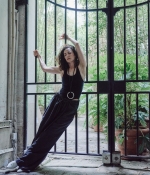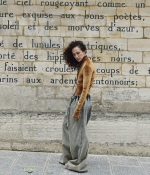Modern Horrors – Q&A Mike Flanagan and Kate Siegel Talk ‘Hush’
On the surface, Hush may seem like your typical home invasion thriller. But its simple premise only serves as the foundation for director/writer Mike Flanagan (Oculus, Absentia) and his co-writer/leading lady Kate Siegel to create a highly intelligent thriller with rare plausibility not typically found in the sub-genre. The film premiered just a scant few weeks ago in Austin, Texas for the SXSW Film Festival (our review here), and luckily audiences didn’t have to wait long to see for themselves.
Just ahead of the film’s global release on Netflix, today, April 8th, 2016, Modern Horrors chatted with Mike Flanagan and Kate Siegel on their very unique, yet highly entertaining writing process and the meticulous planning involved for creating an atypical level of intelligence.
I’ve heard that the concept began over a dinner conversation and Kate’s fear of sliding glass doors? How did it evolve from there?
Siegel: (Laughing) Not so much a huge fear of sliding glass doors, but now I have one. The fear I had was living in a house with a lot of windows at night, walking by uncovered windows and the fear of seeing someone’s face in the window outside.
There is a lot of detail involved, between the vital sound design, to Maddie’s backstory, to the atypical level of intelligence of the characters. How much planning went into the story prior to production?
Siegel: I think what lead to that level of detail was our writing process, which is Mike would go outside of the house we live in together, and I would stay inside, and he would try to break in to the house. Which was REALLY great for my fear of sliding glass doors. But when we found something that was striking a solid chord with one of us, or I would say “I would never do this next” or he would say “I would come into the house now” we had to backup and find new ways to make it believable. Because one of the things we always felt was that Maddie was less a final girl and more of an action hero, with a lot of cues from Die Hard, actually; someone who’s using the entire inside to defeat an outside force. So Mike and I would play around the house or outside the house and then when we got through a set piece that we thought was both realistic and, like you said, smart, we would come inside and write that down.
Flanagan: Yeah, that pretty much, it was a lot of trial and error to make sure that we were never going to have the characters doing something that we feel like we would never do in a similar situation. That’s tough with movies like this because there’s an element where you think you know exactly what you would do and you think you’d know how you’d react, but in the immediacy of a moment where your life is actually in danger? People don’t react the way they normally would.
Siegel: And also, panic floods your mind and your instincts slow down a little bit. So you make mistakes you wouldn’t normally make if you weren’t absolutely mortified. I spoke to some people who’d experienced break ins or peeping toms and there’s always this moment, between 10-15 seconds, of this rabbit caught in the headlights, because you don’t expect it to actually happen to you. Your heart speeds up fast and your breath catches in your throat, and we wanted to make sure those moments would fit, that Maddie wasn’t a heroine who was just capable of fighting someone off right away. She had to learn to go through that journey.
I love that moment where she’s struggling with the crossbow. It just conveyed that authenticity you were going for.
Siegel: One of the fun things we learned about a crossbow is that it’s tightened to the specifications of its shooter. It was kind of a gift given to us when we were studying our weapon, that it could be tightened that way; that a man’s forearm strength is going to be much stronger than a woman.
Flanagan: It was tough for even John (Gallagher) to load the crossbow. We tried to show as much of that as we could, he had to drop it to the ground and stand on it in order to reload it. That was what Gallagher had to do to it. They’re actually really difficult weapons. So once we saw what he had to go through we were like, “Oh, this is great! When we give Maddie the crossbow we should really milk how realistically difficult this is.”
Siegel: Yeah. In a lot of those moments I was trying as hard as I could to pull that thing up.
That’s actually really cool. Maddie’s impairments never felt like a gimmick, and a lot of that was due to Kate’s performance. So much emotion was conveyed simply through her breathing. How did you prepare for the role?
Siegel: I worked very closely with a coach who drilled me relentlessly on the sign language, but that was only kind of the first level of help she gave me. She also talked to me a lot about the community, directed me towards websites, message boards, books to read about experiences of what being deaf in the world is like. Then, armed with that information, when I landed in Alabama, I would isolate myself through earplugs or choosing not to interact, and obviously not speaking, and as an actor when I approached that I was really taking away most of my toolbox. Which is, I can’t talk and I can’t listen. And when you take those away really the only thing left is the breathing. It’s kind of the last human experience that we can all share. The act of communicating on screen is what draws the audience into the mindset of the character, and so I had to find something that was universal even though I’ve taken away two of Maddie’s most common senses. So the breathing became a way of listening almost, and expressing emotion without sound.
Flanagan: What was kind of funny from my perspective with that was, a lot of the breathing that you hear in the film was created in post-production. Because Kate, whenever she had to move, you know we had a steady cam operator, a spotter, and a boom operator moving with her. So much of our production audio wasn’t usable. It sounded like a herd of people moving throughout the house, because it was like 5 or 6 people following Kate. Which meant that she had to come in for a really bizarre ADR session in post, where she just had to come in and breathe and recreate her breath performance over the course of 4 or 5 hours. That was really fascinating. It’s one of those things that you don’t really think about but was pretty wild.
That sounds like a really exhausting ADR session.
Siegel: It was! It was also exhilarating; it was a chance to do something new. I reached acting levels that I hadn’t known.
Flanagan: And it would be like, “Can you breathe more relieved?” or “Breathe more scared!” or “Breathe more exhausted.” Like, the different types of breath.
Siegel: Or, so bizarre, trying to express the act of sobbing without making any noise. But like, the full act. Because I think we all go through a breathing experience when we cry, but when you get to the point where you would be wailing, now try to express that through your breath without making any sound as someone who isn’t capable of making any sound. Because what Maddie is experiencing in that moment is full wailing, if we were in her head she would be hearing herself sobbing. So it needed to sound like that but if you didn’t have vocal chords. Super intense.
So I take it you had to do more cat and mouse play at the new location?
Siegel: Yeah, and go, “Where would you go? What would you do?” You know, what are the options?
Flanagan: We had a whole thing involving an attic in the original draft, but this house didn’t have an attic. We had to play with the loft space and rewrite the whole mechanic. The entire final showdown took place in the attic, and we got rid of that.
Siegel: What’s interesting is that our California home has one level and attic, and that almost never happens in the south, so what we came up against is if there’s a full second story to a house then our whole script is in trouble because you just run upstairs, barricade the stairs and then hang out there. We needed to find a one level house with a space we can get up to the roof and we were lucky to find this house.
Speaking of The Man, I love that he doesn’t have much of a backstory. When he reveals himself, he’s also a bit unassuming. John Gallagher seems like your everyday type of person, which in a way makes this more terrifying. I assume that was always the goal with his character; that this could happen at any time to any one?
Siegel: In the writing of it, I think Mike can talk more about the casting of it and John’s work, but in the writing of it we could never find an organic placement in our cat and mouse game for Mike to stop and talk to me about what he’s doing. It didn’t make any sense. It didn’t happen for us. So when we sat down to write it, by the time we reached the end we realized it’s better if he never explains why.
Flanagan: Yeah. I tend to think, when you’re dealing with evil, in the world and in movies, if you try to put a backstory on it, it can work against the suspense. Because there’s no explanation that’s acceptable. What we’d really wanted to do is we were looking at guys like Ted Bundy and Dennis Rader, the BTK Killer, who were so unassuming and charming and nice that even their friends and family, after they’d confessed to be murderers, didn’t believe it. That, to us, is more scary than if when he pulls off the mask and you see this guy that looks like a monster and you’re like, “Oh yeah, that guy is a killer!” So we really wanted it to be someone you could bump into at Whole Foods and assume that’s just a nice guy.
Siegel: I think it really throws Maddie off her heels because Maddie, like all of us, is expecting someone walking around in a mask to be a monster so when she sees this face, this empty vacant performance that John is giving, it’s really chilling. That look in his eyes. It reminds her that all of the rules she thought she had were off. The types of things she believed about these types of people were gone.
It definitely worked. I don’t feel this needs a sequel, but please tell me you guys are collaborating on a future genre project?
Siegel: We think we are, we’ve been tossing around this idea of a film rep company, so every two years the same main players and cast get back together; Mike, probably Trevor (Macy) and do a nice low budget, or maybe medium budget, genre movie where everyone gets to move around within that, so maybe I’ll be the villain and Samantha Sloyan could be the girl in trouble, or maybe Michael Trucco could be the boy in trouble, you know, just kind of switch it up. We all had such a great time working together, so future collaboration is definitely on the table.
April 8, 2016
Source
by Meagan Navarro









